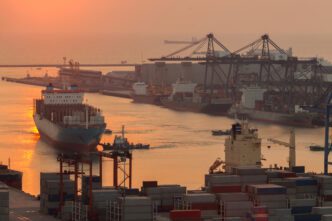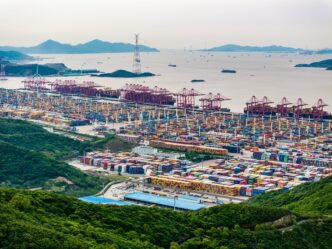The U.S. economy faces potential stagnation in 2025, largely due to newly imposed tariffs, with recovery not anticipated until 2026. Jay Bryson, chief economist at Wells Fargo, has expressed concerns about the fragility of the current economic conditions. Although Bryson stops short of predicting an official recession, he indicates that the economy is precariously close to contraction. Any additional shocks, whether from policy changes or external factors, could push it into recession territory.
Bryson’s insights come as several economic indicators show signs of stress, significantly impacted by these tariffs. He predicts that 2025 will experience slowed growth, primarily due to trade disruptions and protectionist measures. Looking ahead to 2026, Bryson expects an economic rebound driven by potential monetary policy adjustments, moderate fiscal stimulus, and regulatory rollbacks. He foresees a significant shift in the Federal Reserve’s approach, with the possibility of substantial interest rate cuts. Currently, interest rates stand between 4.25% and 4.50%, but Bryson suggests they could be reduced to around 1% within a year if unemployment rises, prompting the central bank to act more aggressively to stimulate the economy.
What the Tariff Forecast Means for Florida’s Economy
Florida’s economy, with its heavy reliance on international trade, tourism, and agriculture, is uniquely susceptible to the effects of national tariff policies. The state’s major ports, including PortMiami, Port Everglades, and the Port of Jacksonville, serve as critical gateways for imports and exports, making them particularly vulnerable to trade disruptions.
The Risks for 2025
The newly implemented tariffs pose several significant risks to Florida’s economy in 2025, impacting key industries, employment, and consumer purchasing power.
International Trade and Logistics: Florida is the eighth-largest destination for imports in the U.S., having received over $112 billion in merchandise goods in 2022 from countries heavily impacted by tariff plans, such as China, Japan, and members of the European Union. Tariffs are essentially taxes on imported goods, making them more expensive for Florida businesses and consumers. This will lead to higher operational costs for logistics businesses, impacting how goods are moved, stored, and priced.
- Ports: PortMiami, Port Everglades, and JAXPORT are on high alert. While PortMiami and Port Everglades have a diversified trade pattern, with a significant portion of trade with Latin America and the Caribbean, which are currently on the lower end of impacted tariffs, slowdowns are still anticipated. PortMiami, for instance, saw China as its number one import country in 2023, and businesses are already experiencing canceled orders due to increased costs from tariffs. JAXPORT, though less dependent on China for its overall container volume, is still monitoring the situation closely, as economic uncertainty could impact imports.
- Supply Chains: Researchers from Florida Atlantic University indicate that the economy could be headed for a downturn as the supply chain begins to contract due to tariff policies and rising uncertainty. Increased material costs and administrative complexities are already having considerable effects on global supply chains.
Key Industries:
- Construction and Real Estate: These sectors are particularly vulnerable. The cost of imported materials like Italian tiles, Canadian wood, and Mexican drywall could increase, driving up the price of new homes and renovations. According to the National Association of Home Builders (NAHB), tariffs could add between $7,500 and $10,000 to the price of a new home. Small businesses, especially those relying on imported steel and aluminum for construction, are already feeling the pinch.[2]
- Tourism: Florida’s vital tourism industry is facing uncertainty. A 10% drop in Canadian visitors alone could result in 2 million fewer visits nationwide, leading to $2.1 billion in lost spending and 14,000 job losses. While some areas like Winter Haven and Polk County, which rely heavily on sports tourism, might be less impacted, broader Central and South Florida regions could see declines in international visitors. Consumer confidence, which has been declining in Florida for three consecutive months due to tariff concerns, also impacts travel decisions.
- Agriculture: The citrus industry, already struggling with greening disease and reduced acreage, faces a “pro and con” impact. While tariffs could potentially provide Florida farmers with a more competitive domestic marketplace by making foreign produce more expensive, retaliatory tariffs from countries like Canada on Florida orange juice and grapefruit could hurt exports. Mexico, a major exporter of produce to the U.S. and a source for Florida’s juice processors, is also subject to tariffs. The seafood industry, particularly tilapia production, might see some opportunities for local production as tariff uncertainty disrupts global supply chains.
- Consumer Prices and Cost of Living: Tariffs are expected to directly impact consumer prices, increasing the cost of everyday goods. This is essentially a tax on consumption, with economists estimating an average U.S. household loss of $1,500 to $3,800 per year in purchasing power. South Florida’s cost of living is already about 20% higher than the national average, with housing accounting for a large portion of that increase. Tariffs on furniture, household appliances, footwear, and travel goods will disproportionately affect Floridian wallets, leading to higher prices on items like shoes, toys, and cars. Congresswoman Sheila Cherfilus-McCormick (D-FL) has stated that these tariffs will mean “higher prices at a time of sky-rocketing costs” for Florida households.
Florida’s Economy at a Crossroads
An analysis of the projected economic impacts of 2025 tariffs and the anticipated recovery pathway to 2026.
Market Overview: The $1.4 Trillion Stake
Florida’s dynamic economy faces significant headwinds from proposed 2025 tariffs. This report analyzes the primary channels of impact and outlines the strategic shifts necessary for a robust 2026 recovery.
In Goods Through PortMiami
State for Agricultural Exports
Annual Tourists Pre-Tariff
Trade Chokepoint: PortMiami
Florida’s ports are on the front line. While diversified trade provides some resilience, the impact on goods from Asia is a primary concern.
PortMiami Trade Composition
This chart illustrates the composition of trade partners for PortMiami.
Projected Import Decline (2025)
A forecast of the potential decline for key tariff-affected product categories.
Squeeze on Key Industries
Retaliatory tariffs and rising input costs are projected to impact Florida’s cornerstone industries.
Agriculture Export Risk
Citrus
-15%
Tomatoes
-20%
Berries
-12%
Construction Material Cost Index
Impact on the Florida Consumer
Ultimately, tariff costs are passed down, impacting disposable income and economic sentiment.
SWOT Analysis: Florida’s Tariff Response
Strengths
- Diversified Ports
- Strong LatAm Relations
Weaknesses
- High Import Reliance
- Vulnerable Ag. Sector
Opportunities
- Near-Shoring Trend
- Supply Chain Innovation
Threats
- Prolonged Trade Disputes
- Spending Drop
Forecasted Rise in Household Costs (2025)
The Road to 2026 Recovery
A rebound will be driven by diversification, new trade agreements, and stabilizing consumer demand.
Pathway to Economic Stabilization
1. Tariff Negotiation
Global trade deal adjustments
2. Supply Chain Shift
Focus on near-shoring & domestic
3. Demand Stabilization
Consumer confidence returns
4. Growth Resumes
Return to positive GDP trend
Projected GDP Growth (FL vs. USA)
The Path to 2026 Recovery
While 2025 presents challenges, Florida’s economy is resilient, and a recovery is anticipated in 2026, aligning with national trends.
- Monetary Policy Adjustments: The potential for significant interest rate cuts by the Federal Reserve, as predicted by Jay Bryson, would stimulate the economy by making borrowing cheaper for businesses and consumers. The Florida Chamber of Commerce also anticipates 1-2 interest rate cuts in 2025, which could fuel investment and homeownership.
- Manufacturing Expansion: Florida is working to strengthen its manufacturing sector to reduce reliance on imports. While tariffs may temporarily raise prices, long-term growth in manufacturing will strengthen the state’s economy.
- Diversified Trade and Supply Chains: Businesses are already exploring alternative sourcing options and diversifying their supply chains to mitigate tariff impacts. This strategic adaptation will be key to thriving in the evolving economic landscape. The ability of ports to diversify their trade patterns, as seen in PortMiami’s strong ties to Latin America and the Caribbean, may provide some buffer against the most heavily impacted trade routes.
- Tourism Adaptation: Florida’s tourism industry, while facing short-term headwinds, is expected to remain strong overall. Areas that have diversified their tourism offerings, such as those focused on sports tourism, may prove more resilient.
- Resilient Job Market and Business Environment: Despite consumer anxieties, Florida’s job market remains strong, and the state continues to attract businesses relocating from other regions. This business-friendly climate provides a solid foundation for long-term growth.
Forward-Looking Statement
As Florida navigates the economic uncertainties of 2025, residents and businesses should prepare for potential increases in the cost of imported goods and services, which could impact everything from daily expenses to the price of new homes. While the immediate outlook points to a period of slower growth driven by trade disruptions, the state’s underlying economic strengths, coupled with anticipated monetary policy adjustments and a push towards domestic manufacturing, position Florida for a robust recovery in 2026. The ability of Florida’s key industries to adapt and diversify will be crucial in leveraging the eventual national rebound.








